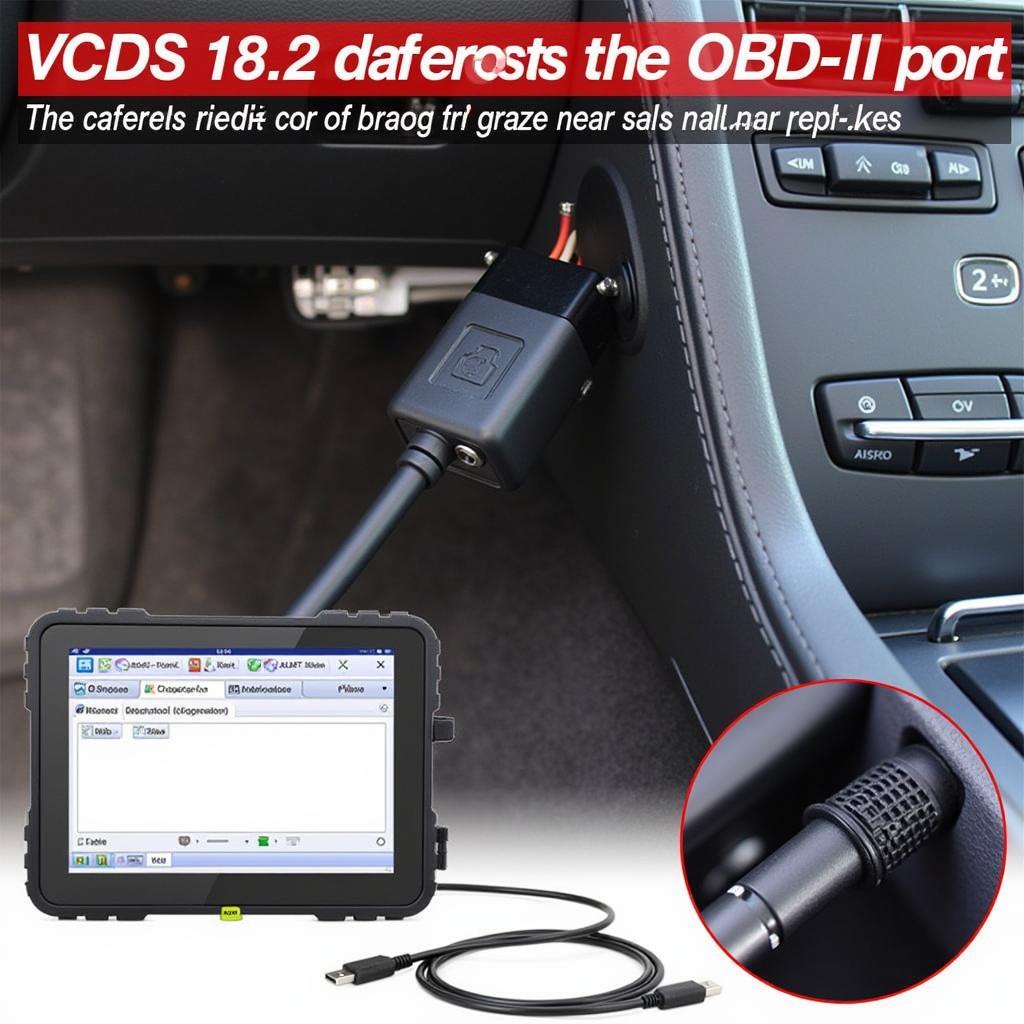Your cart is currently empty!

How to Use VCDS 18.2: A Comprehensive Guide for Automotive Diagnostics
VCDS 18.2 is a powerful diagnostic tool for Volkswagen, Audi, Seat, and Skoda vehicles. This guide will teach you how to use VCDS 18.2 effectively, from basic connection procedures to advanced troubleshooting. Whether you’re a seasoned technician or a car enthusiast, this guide will equip you with the knowledge to diagnose and fix car problems with confidence.
 VCDS 18.2 Interface Connection to Car’s OBD-II Port
VCDS 18.2 Interface Connection to Car’s OBD-II Port
Getting started with VCDS 18.2 can seem daunting, but with the right guidance, it becomes a user-friendly tool. vcds 18.2 user manual provides a great starting point.
Connecting VCDS 18.2 to Your Vehicle
Before diving into diagnostics, you need to establish a connection between your computer and your vehicle. This involves installing the VCDS 18.2 software and connecting the interface cable. Ensure your laptop meets the system requirements and the drivers are correctly installed. Then, plug the interface cable into your vehicle’s OBD-II port and connect the other end to your computer.
Testing the Connection
Once connected, open the VCDS 18.2 software and select “Options.” Check the “Test” button to confirm communication between the software and the interface. A successful test indicates a proper connection. If you encounter issues, double-check the cable connections, drivers, and vcds user guide.
What if my connection test fails? Troubleshooting connection problems can involve checking cable connections, USB ports, and driver installations.
Performing Basic Diagnostics with VCDS 18.2
After establishing a connection, you can start performing basic diagnostics.
-
Select the Control Module: Choose the specific control module you want to diagnose, such as the engine, transmission, or ABS.
-
Read Fault Codes: Click on “Fault Codes – 02” to retrieve any stored Diagnostic Trouble Codes (DTCs).
-
Interpreting Fault Codes: VCDS 18.2 provides detailed descriptions of each DTC, which can help you identify the root cause of the problem.
How do I clear fault codes after a repair? After addressing the issue causing the fault code, you can clear the codes using the “Clear Codes – 05” function in VCDS 18.2.
Advanced Functions of VCDS 18.2
Beyond basic diagnostics, VCDS 18.2 offers advanced functions such as:
Measuring Values
VCDS 18.2 allows you to monitor live data streams from various sensors in real time. This can help you identify intermittent problems and verify repair effectiveness.
Basic Settings
This function allows you to perform specific tests and calibrations for different control modules.
Coding and Adaptations
VCDS 18.2 enables you to change the coding of certain control modules and perform adaptations to customize various vehicle settings. This can be useful for enabling hidden features or adjusting existing ones.
“Using the advanced functions of VCDS 18.2 opens up a whole new level of diagnostic capability. It’s like having a direct line of communication with your car’s brain,” says John Miller, Senior Automotive Diagnostic Technician.
vcds micro-can interface provides a reliable connection for all your diagnostic needs.
Staying Up-to-Date with VCDS 18.2
Regular updates ensure compatibility with the latest vehicle models and provide bug fixes and performance improvements. Always refer to vcds crack update for genuine and safe updates. Avoid using torrent serial vcds loader 18.2 as it can compromise your software and potentially harm your vehicle’s systems.
“Staying up-to-date with the latest VCDS software is crucial for accurate diagnostics and access to the newest features. It’s an investment in your diagnostic capabilities,” states Maria Sanchez, Lead Automotive Engineer at a prominent German car manufacturer.
Conclusion
VCDS 18.2 is an invaluable tool for diagnosing and resolving issues in VAG vehicles. By understanding the basic and advanced functions, you can efficiently troubleshoot problems, saving time and money. We hope this comprehensive guide on how to use VCDS 18.2 has empowered you to tackle automotive diagnostics with confidence. For further assistance and support, connect with us at vcdstool, +1 (641) 206-8880 and our email address: vcdstool@gmail.com, or visit our office at 6719 W 70th Ave, Arvada, CO 80003, USA.
by
Tags:
Leave a Reply